The National Museum of Anthropology in Mexico City offers a captivating exploration of Mexico’s rich cultural heritage. Through exhibits showcasing the sophisticated beliefs of ancient Mesoamerican civilizations, visitors embark on a journey that illuminates the intricate cosmovision of the Aztecs and Maya. From the significance of feminine deities to the symbolism of celestial bodies and animals, this immersive experience conducted in Spanish unveils the interconnectedness of artistic expression and cultural identity. Iconic artifacts, including a replica of Pakal the Great’s tomb, provide visitors with a deeper understanding of the duality that underpins the Mesoamerican worldview. Prepare to be captivated by this remarkable window into Mexico’s past.
Key Points
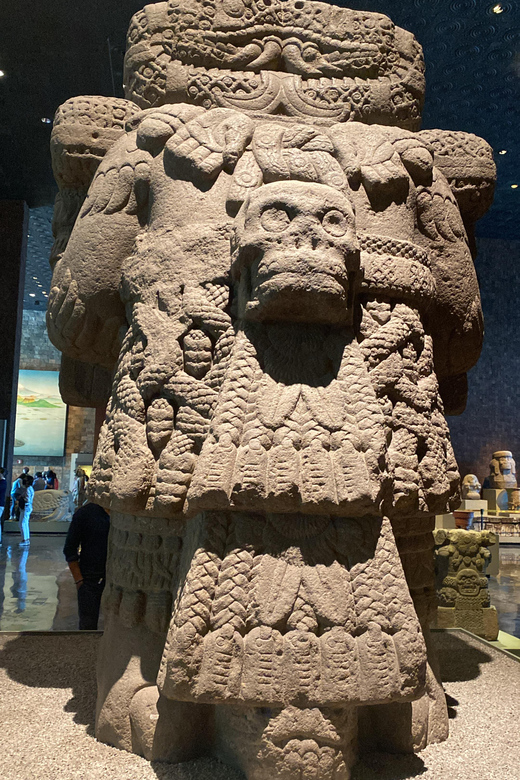
-
The National Museum of Anthropology offers a comprehensive guided tour of Mesoamerican civilizations, including the influential Teotihuacan and Mexica (Aztec) cultures, in the Spanish language.
-
The tour delves into the profound Mesoamerican cosmovision, highlighting the significance of feminine deities, celestial bodies, and intricate animal symbolism in ancient art and beliefs.
-
Visitors can explore the replica of Pakal the Great’s tomb, which showcases the advanced funerary practices and spiritual beliefs of the Maya civilization.
-
The museum’s collection features striking duality murals and sculptures that provide insights into the ancient Mexican peoples’ understanding of opposing yet complementary forces.
-
The 3-hour tour is conducted in Spanish for groups of up to 10 people, with accessibility features and practical guidelines for visitors to enhance their experience.
Exploring Mesoamerican Cosmovision
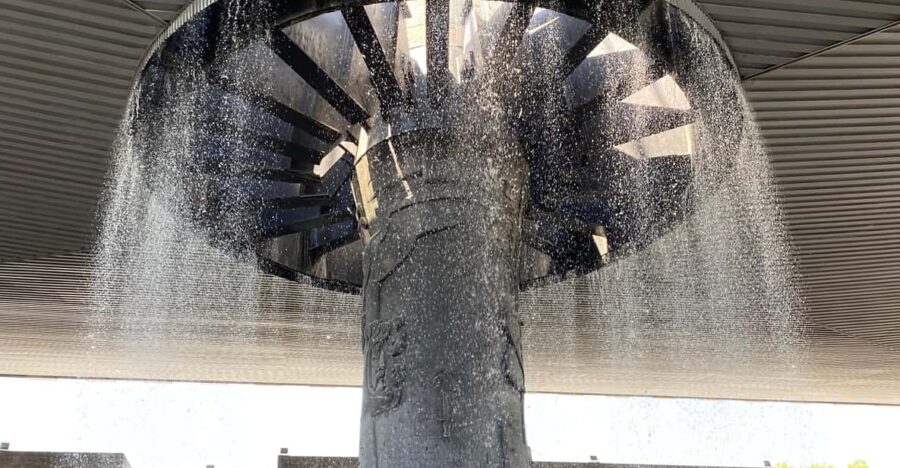
Deeply embedded in the cultural heritage of ancient Mexican civilizations, the cosmovision of Mesoamerica reflects a sophisticated worldview that revolved around the intricate interplay of natural, supernatural, and human elements.
This tour explores the significance of feminine deities, the symbolic language of art, and the celestial bodies that were central to the belief systems of peoples like the Aztecs and Maya.
Visitors will explore the rich symbolism that shaped the worldview of these ancient civilizations, gaining a deeper understanding of how their unique perspectives continue to influence modern Mexican culture.
Ready for more culture? More museums we feature in Mexico City
Significance of Femininity in Art
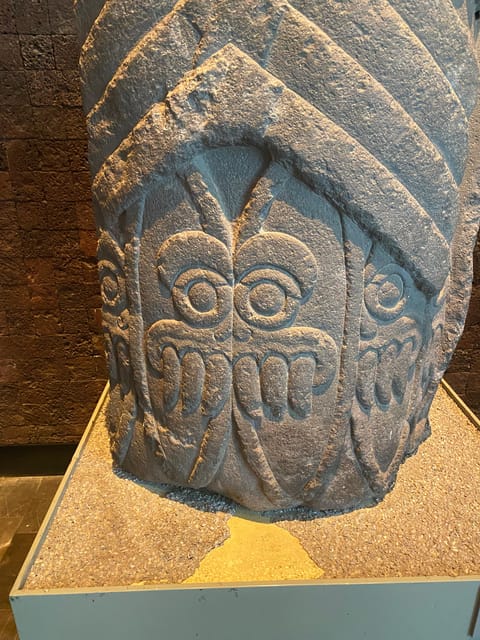
At the heart of Mesoamerican cosmovision lies a profound reverence for the divine feminine. Through art, ancient Mexicans celebrated the intricate role of womanhood, its power, and its sacredness. Representations of female deities, fertility symbols, and maternal imagery abound in the museum’s exhibits. A closer examination reveals the depth of this veneration:
| Vessel Designs | Pictograms | Stone Carvings | Celestial Bodies |
|---|---|---|---|
| Curves, swirls, and organic shapes evoke the female form. | Feminine symbols like flowers, vulvas, and birthing imagery. | Powerful goddesses, like Coatlicue, depicted in elaborate detail. | The moon, a primary feminine symbol, was deeply revered. |
This expansive visual language underscores the centrality of the feminine divine in Mesoamerican worldviews.
Animal Symbolism in Mesoamerica
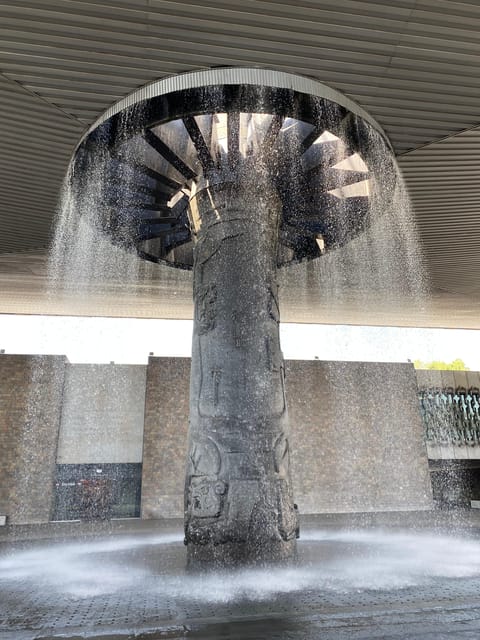
Alongside the veneration of the divine feminine, the ancient peoples of Mesoamerica also imbued animals with profound symbolic significance.
The snake, for instance, represented duality, rebirth, and the connection between the earthly and divine realms. The eagle, meanwhile, symbolized power, vision, and the sun’s dominance.
The jaguar, revered for its strength and night-hunting prowess, was associated with the underworld and the spiritual realm.
These animals featured prominently in Mesoamerican art, from intricate stone carvings to detailed ceramic vessels, conveying the deep interconnectedness between the natural and supernatural worlds that underpinned the cosmovision of these ancient cultures.
Celestial Bodies in Ancient Cultures
The celestial bodies held profound significance for the ancient peoples of Mesoamerica, who saw them as portents of great cosmic events and channels through which the divine interacted with the mortal realm.
The sun, moon, and stars were deeply revered, with complex cosmological systems developed to track their movements and interpret their meanings.
Representations of these celestial entities feature prominently in Mesoamerican art and architecture, from the pyramids of Teotihuacan to the stone carvings of the Maya.
More Great Thing To Do NearbyDuality in Mesoamerican Worldview
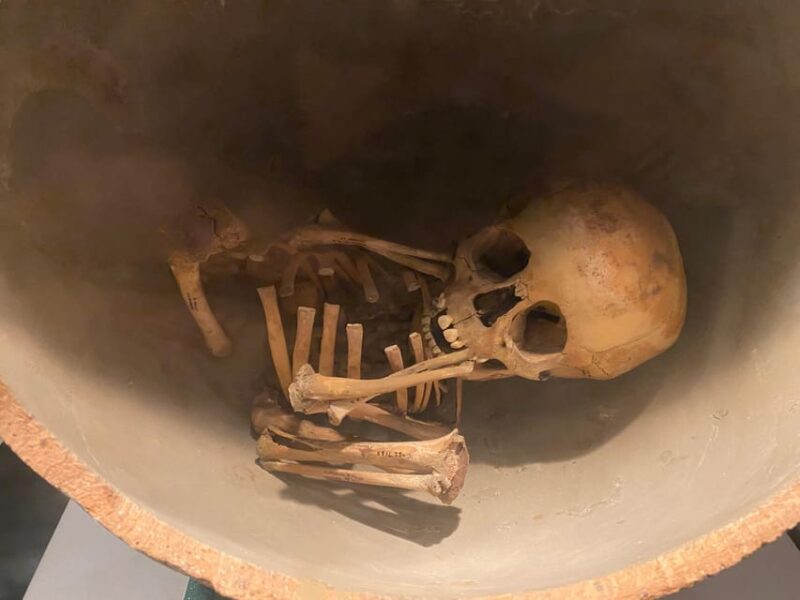
Duality permeated the worldview of Mesoamerican civilizations, with the interplay of opposing yet complementary forces – male and female, light and dark, life and death – underpinning their understanding of the cosmos.
This concept manifested in their art, from the striking duality mural to the symbolic representation of animals like the snake, eagle, and jaguar.
The significance of celestial bodies like the sun and moon further reinforced the centrality of duality in their cosmovision.
Exploring these intricate beliefs at the National Museum of Anthropology offers visitors a unique window into the worldview of ancient Mexican peoples.
- Hot Air Balloon Flight Over Teotihuacan, From Mexico City
- San Miguel De Allende Tour From Mexico City
- Balloon Flight With Pick up in Mexico City + Breakfast in a Natural Cave
- The Emperor Route, Chapultepec & Paseo De La Reforma Historical Bike Tour
- Frida Kahlos House, Coyoacan and Xochimilco – All Day Tour
- Polanco Food Tour in Mexico City
Teotihuacan and Mexica Civilizations
The tour explores the remarkable civilizations of Teotihuacan and the Mexica (Aztec) at the National Museum of Anthropology.
Visitors discover the influential Teotihuacan civilization, marveling at the museum’s expansive Teotihuacan Room. Artifacts and displays shed light on this ancient metropolis, its architectural wonders, and cultural achievements.
The tour then delves into the Mexica civilization, the powerful Aztec empire that dominated central Mexico. The Mexica Room showcases their sophisticated cosmovision, from captivating stone carvings to vibrant murals.
Participants also view the replica of the tomb of Pakal the Great, a revered Mayan ruler, gaining insights into the interconnected cultures of Mesoamerica.
Pakal the Great’s Tomb Replica
A highlight of the museum tour is the replica of Pakal the Great’s tomb, enabling visitors to marvel at the intricate artistry and symbolic significance of this revered Mayan ruler’s final resting place.
The tomb’s intricate stone carvings depict Pakal’s journey to the underworld, the celestial symbols representing his ascension to the heavens.
Visitors can closely examine the magnificent jade mask and ornaments that adorned Pakal’s remains, providing a glimpse into the sophisticated Mayan funerary practices.
This faithful reproduction allows guests to gain a deeper understanding of the profound spiritual beliefs and advanced artistic accomplishments of the ancient Maya civilization.
Practical Information for Visitors
To visit the National Museum of Anthropology in Mexico City, guests can easily find the museum located within the Chapultepec Forest.
The tour lasts 3 hours and is conducted in Spanish for groups of up to 10 participants. The museum is wheelchair accessible, and there’s a free cancellation policy up to 24 hours in advance.
Visitors should come prepared with comfortable shoes and clothes, as the tour involves standing for long periods.
Photography with flash, drones, large bags, and food/drinks aren’t allowed.
The tour is designed for adults seeking a deeper understanding of ancient Mexican cultures and their worldviews.
Frequently Asked Questions
Can I Purchase Souvenirs at the Museum Gift Shop?
Yes, visitors can purchase souvenirs at the museum gift shop. The gift shop offers a variety of traditional Mexican handicrafts, books, and other items related to the museum’s exhibits and ancient Mexican cultures.
Is There a Coat Check or Storage Facility Available?
There is no dedicated coat check or storage facility available on-site. Visitors are advised to avoid bringing large bags or items that could interfere with the tour experience. Small personal belongings can be carried during the guided exploration.
Are There Any Discounts or Concessions for Students or Seniors?
There are no student or senior discounts mentioned for this tour. However, the museum itself may offer general admission discounts that could apply. It’s best to check the museum’s website or with the tour operator for the most up-to-date information.
Can I Take Photos With a Professional Camera During the Tour?
No, professional cameras are not allowed during the tour. The tour guidelines specifically state that flash photography, professional cameras, and drones are prohibited to ensure the preservation and enjoyment of the museum exhibits for all participants.
Is There a Restroom or Drinking Water Available on the Tour Route?
There are no restrooms or water fountains available along the tour route. However, the museum has public facilities near the entrance that can be accessed before or after the guided tour.
Recap
The National Museum of Anthropology in Mexico City offers an immersive exploration of Mexico’s rich cultural heritage. Visitors can explore the sophisticated beliefs and artistic expressions of ancient Mesoamerican civilizations, discovering the significance of feminine deities, celestial bodies, and animal symbolism. The guided tour provides insights into iconic artifacts, emphasizing the interconnectedness of cultural identity and artistic tradition. It’s an enlightening experience that transports visitors to the heart of Mexico’s captivating past.
You can check if your dates are available here:More Museum Experiences in Mexico City
More Tour Reviews in Mexico City
Not for you? Here's more things to do in Mexico City we have recnetly reviewed
- 3 Best Canoe And Kayak Experiences In Mexico City
- 7 Best 2 Day Tours In Mexico City
- 16 Best Cruises And Boat Tours In Mexico City
- 9 Best Dining Experiences In Mexico City
- 10 Best Full-Day Tours In Mexico City
- 3 Best 3 Day Tours In Mexico City
- 2 Best Coffee Tours And Tastings In Mexico City
- 7 Best Dinner Tours In Mexico City
- 25 Best Food Tours In Mexico City
- 8 Best Lunch Experiences In Mexico City
- Xochimilco: the Island of the Dolls, Games and Drinks
- Private Pick up Mexico Citys Airport
